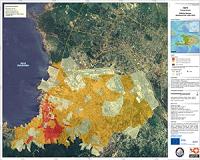 |
Washington DC (SPX) Jan 18, 2010 A magnitude 7.0 earthquake occurred on January 12, 2010, at Port-au-Prince, Haiti, with major impact to the region and its citizens. This perspective view of the pre-quake topography of the area clearly shows the fault that is apparently responsible for the earthquake as a prominent linear landform immediately adjacent to the city. Elevation is color coded from dark green at low elevations to white at high elevations, and the topography is shaded with illumination from the left. The topography in this image is exaggerated by a factor of two. The sharp diagonal line exactly at the image center is the Enriquillo fault. Port-au-Prince is immediately to the left (north) at the mountain front and shoreline. The Enriquillo fault generally moves left-laterally (horizontally, with features across the fault shifting to the left when the fault breaks in an earthquake), but vertical movements occur along the fault where irregularities in the fault line cause local compression or extension of the earth. Meanwhile, movements of the topography at the Earth's surface can falsely appear to be vertical where mountain slopes are cut and misaligned by horizontal shifts of the fault. Additionally, differing erosion rates on the two sides of the fault, due to the juxtapositioning of differing rock types by the fault, can give the appearance of vertical offsets of the current topographic surface. All of these real and apparent horizontal and vertical offsets of the topographic surface may (and likely do) occur here, making the fault easily observed in the topographic data. The elevation data used in this image were produced by the Shuttle Radar Topography Mission (SRTM), flown aboard Space Shuttle Endeavour in February 2000. SRTM acquired elevation measurements for nearly all of Earth's landmass between 60 degrees North and 56 degrees South latitudes. For many areas of the world, SRTM data provide the first detailed three dimensional observation of landforms at regional scales. The mission was a cooperative project between the National Aeronautics and Space Administration (NASA), the National Geospatial-Intelligence Agency (NGA) of the U.S. Department of Defense (DOD), and the German and Italian space agencies. It was managed by NASA's Jet Propulsion Laboratory, Pasadena, Calif., for NASA's Science Mission Directorate, Washington, D.C. View Width: One degree latitude (111 kilometers, or 69 miles) View Distance: Five degrees longitude (525 kilometers, or 325 miles) Location: 18 to 19 degrees North latitude, 70 to 75 degrees West longitude Orientation: View east, 5 degrees below horizontal SRTM Data Acquired: February 2000 Share This Article With Planet Earth
Related Links Shuttle Radar Topography Mission Earth Observation News - Suppiliers, Technology and Application
 New Satellite Maps Of Haiti Coming In
New Satellite Maps Of Haiti Coming InParis, France (SPX) Jan 18, 2010 As rescue workers scramble to provide assistance to hundreds of thousands of people following Haiti's earthquake, Earth observation satellite data continues to provide updated views of the situation on the ground. Following the 7.0-magnitude earthquake that hit Haiti on 12 January, international agencies requested satellite data of the area from the International Charter on 'Space and Majo ... read more |
|
| The content herein, unless otherwise known to be public domain, are Copyright 1995-2009 - SpaceDaily. AFP and UPI Wire Stories are copyright Agence France-Presse and United Press International. ESA Portal Reports are copyright European Space Agency. All NASA sourced material is public domain. Additional copyrights may apply in whole or part to other bona fide parties. Advertising does not imply endorsement,agreement or approval of any opinions, statements or information provided by SpaceDaily on any Web page published or hosted by SpaceDaily. Privacy Statement |